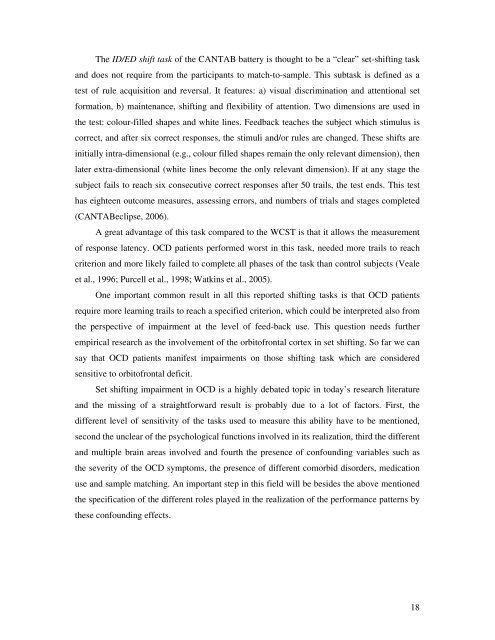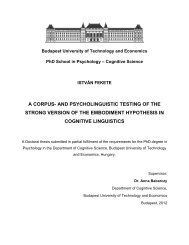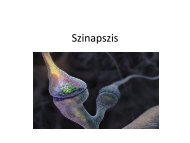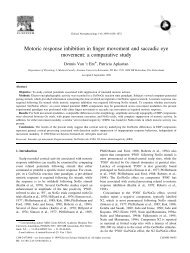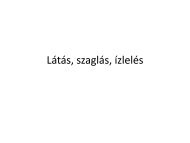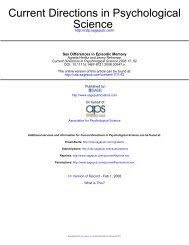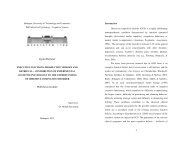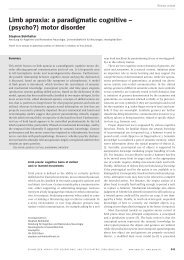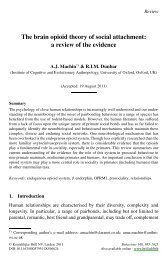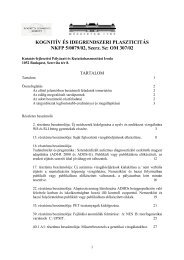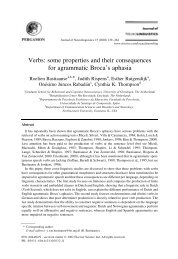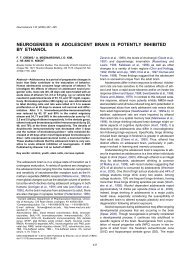Gyula Demeter
Gyula Demeter
Gyula Demeter
Create successful ePaper yourself
Turn your PDF publications into a flip-book with our unique Google optimized e-Paper software.
The ID/ED shift task of the CANTAB battery is thought to be a “clear” set-shifting task<br />
and does not require from the participants to match-to-sample. This subtask is defined as a<br />
test of rule acquisition and reversal. It features: a) visual discrimination and attentional set<br />
formation, b) maintenance, shifting and flexibility of attention. Two dimensions are used in<br />
the test: colour-filled shapes and white lines. Feedback teaches the subject which stimulus is<br />
correct, and after six correct responses, the stimuli and/or rules are changed. These shifts are<br />
initially intra-dimensional (e.g., colour filled shapes remain the only relevant dimension), then<br />
later extra-dimensional (white lines become the only relevant dimension). If at any stage the<br />
subject fails to reach six consecutive correct responses after 50 trails, the test ends. This test<br />
has eighteen outcome measures, assessing errors, and numbers of trials and stages completed<br />
(CANTABeclipse, 2006).<br />
A great advantage of this task compared to the WCST is that it allows the measurement<br />
of response latency. OCD patients performed worst in this task, needed more trails to reach<br />
criterion and more likely failed to complete all phases of the task than control subjects (Veale<br />
et al., 1996; Purcell et al., 1998; Watkins et al., 2005).<br />
One important common result in all this reported shifting tasks is that OCD patients<br />
require more learning trails to reach a specified criterion, which could be interpreted also from<br />
the perspective of impairment at the level of feed-back use. This question needs further<br />
empirical research as the involvement of the orbitofrontal cortex in set shifting. So far we can<br />
say that OCD patients manifest impairments on those shifting task which are considered<br />
sensitive to orbitofrontal deficit.<br />
Set shifting impairment in OCD is a highly debated topic in today’s research literature<br />
and the missing of a straightforward result is probably due to a lot of factors. First, the<br />
different level of sensitivity of the tasks used to measure this ability have to be mentioned,<br />
second the unclear of the psychological functions involved in its realization, third the different<br />
and multiple brain areas involved and fourth the presence of confounding variables such as<br />
the severity of the OCD symptoms, the presence of different comorbid disorders, medication<br />
use and sample matching. An important step in this field will be besides the above mentioned<br />
the specification of the different roles played in the realization of the performance patterns by<br />
these confounding effects.<br />
18


